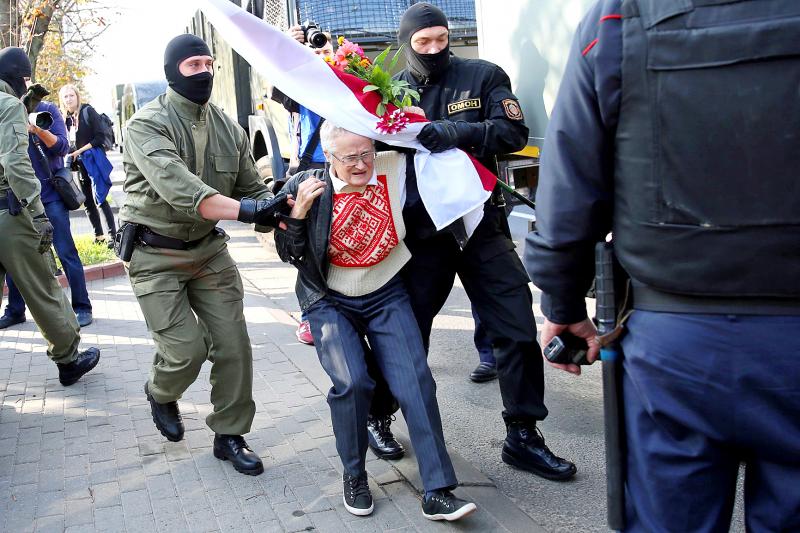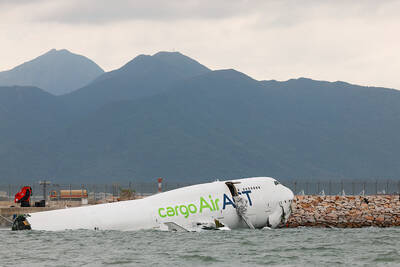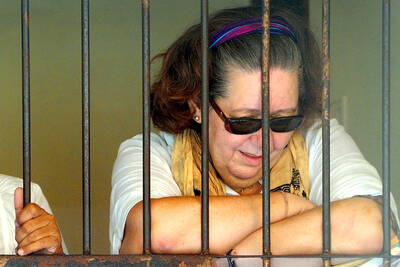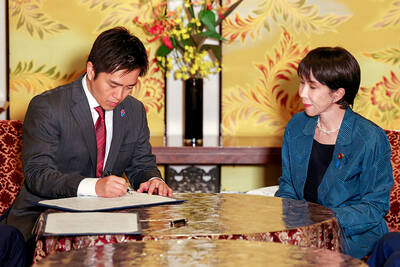Riot police in Belarus on Saturday bundled hundreds of women, including a great-grandmother who has become an icon of the protest movement, into vans as opposition marchers rallied in Minsk seeking an end to Belarusian President Alexander Lukashenko’s 26-year rule.
The protest was the latest in which Belarusian women have taken to the streets with flowers and flags.
The numbers detained on Saturday were far higher than the previous week’s rally. The women were seized by riot police in black uniforms and balaclavas as well as officers in khaki uniforms and plainclothes officers in masks.

Photo: AFP
Police blocked the women and began pulling them into police vans as they stood with linked hands, swiftly detaining hundreds, an Agence France-Presse journalist said.
Police lifted some women off their feet to remove them.
The Viasna rights group published online the names of 328 women detained, while police spokeswoman Olga Chemodanova told reporters that the number detained would be announced yesterday.
Police detained so many protesters that they ran out of room in vans, the opposition’s Coordination Council said.
About 2,000 women took part in the “Sparkly March,” wearing shiny accessories and carrying red-and-white flags of the protest movement.
Among those detained on Saturday was Nina Baginskaya, a 73-year-old advocate who has become one of the best-known faces of the protest movement, known for her plucky antics and regularly celebrated with a chant of “Nina! Nina!”
Police took away the flag and flowers she was carrying as they pushed her into a van, but released her outside a police station shortly afterward.
The march was the latest in a series of all-women protests calling for the president to leave following his disputed victory in elections last month.
His opposition rival Svetlana Tikhanovskaya also claimed victory.
Tikhanovskaya, who has taken shelter in Lithuania, condemned the “arbitrary” detentions, saying that police without any identifying badges had “roughly detained en masse beautiful and brave women who were protesting lawfully and peacefully.”
The Coordination Council, set up by Tikhanovskaya’s allies to arrange a peaceful handover of power, described the detentions as “a new phase in the escalation of violence against peaceful protesters.”
Tikhanovskaya said that protesters were ready to strip riot police who carry out “criminal orders” of anonymity.
The Poland-based opposition Telegram channel Nexta published a list of more than 1,000 names and ranks of alleged police offenders, saying that it received the data from whistle-blowers and would post more if detentions continued.
Witness accounts of police violence and torture of detainees following the elections have prompted the European Parliament to call for sanctions against Lukashenko and other members of his regime.
The marchers chanted slogans such as “Get out, you and your riot police!” and “We believe we can win!”
One of the placards read: “Our protest has a woman’s face,” a reference to the title of a popular book by the Belarusian Nobel prize winner Svetlana Alexievich, who has backed the opposition cause.
“I will march to the end, until we claim victory, because we are in the right,” said one protester, Irina, a 50-year-old programmer.
Some women managed to run away and took shelter in a nearby nail salon, Tut.by news site reported.
The protest came as the opposition was due to hold mass demonstrations yesterday afternoon in Minsk and other cities.
Tikhanovskaya is to meet EU foreign ministers and the bloc’s diplomatic chief in Brussels today, in a move that Russian Ministry of Foreign Affairs spokeswoman Maria Zakharova condemned as “flirting with a self-appointed representative of the Belarusian opposition.”
The women’s protests began in Belarus after Lukashenko’s use of extreme violence against detained demonstrators.
Women began forming human chains and marching through Minsk and other cities wearing white clothes and carrying flowers in peaceful demonstrations that police initially allowed to go ahead.
Last weekend, police violently detained several dozen at a similar women’s protest.
Lukashenko last week warned of a possible “war” with some neighboring countries and has turned to Russia for support after refusing to step down.

A missing fingertip offers a clue to Mako Nishimura’s criminal past as one of Japan’s few female yakuza, but after clawing her way out of the underworld, she now spends her days helping other retired gangsters reintegrate into society. The multibillion-dollar yakuza organized crime network has long ruled over Japan’s drug rings, illicit gambling dens and sex trade. In the past few years, the empire has started to crumble as members have dwindled and laws targeting mafia are tightened. An intensifying police crackdown has shrunk yakuza forces nationwide, with their numbers dipping below 20,000 last year for the first time since records

CAUSE UNKNOWN: Weather and runway conditions were suitable for flight operations at the time of the accident, and no distress signal was sent, authorities said A cargo aircraft skidded off the runway into the sea at Hong Kong International Airport early yesterday, killing two ground crew in a patrol car, in one of the worst accidents in the airport’s 27-year history. The incident occurred at about 3:50am, when the plane is suspected to have lost control upon landing, veering off the runway and crashing through a fence, the Airport Authority Hong Kong said. The jet hit a security patrol car on the perimeter road outside the runway zone, which then fell into the water, it said in a statement. The four crew members on the plane, which

Indonesia was to sign an agreement to repatriate two British nationals, including a grandmother languishing on death row for drug-related crimes, an Indonesian government source said yesterday. “The practical arrangement will be signed today. The transfer will be done immediately after the technical side of the transfer is agreed,” the source said, identifying Lindsay Sandiford and 35-year-old Shahab Shahabadi as the people being transferred. Sandiford, a grandmother, was sentenced to death on the island of Bali in 2013 after she was convicted of trafficking drugs. Customs officers found cocaine worth an estimated US$2.14 million hidden in a false bottom in Sandiford’s suitcase when

Japan’s ruling Liberal Democratic Party (LDP) and its junior partner yesterday signed a coalition deal, paving the way for Sanae Takaichi to become the nation’s first female prime minister. The 11th-hour agreement with the Japan Innovation Party (JIP) came just a day before the lower house was due to vote on Takaichi’s appointment as the fifth prime minister in as many years. If she wins, she will take office the same day. “I’m very much looking forward to working with you on efforts to make Japan’s economy stronger, and to reshape Japan as a country that can be responsible for future generations,”